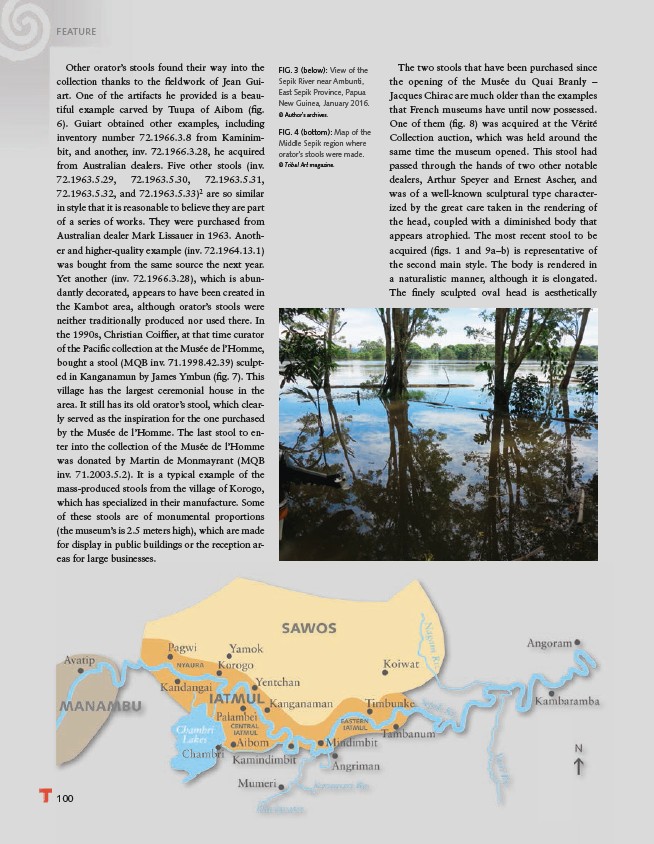
Other orator’s stools found their way into the
collection thanks to the fi eldwork of Jean Guiart.
One of the artifacts he provided is a beautiful
example carved by Tuupa of Aibom (fi g.
6). Guiart obtained other examples, including
inventory number 72.1966.3.8 from Kaminimbit,
and another, inv. 72.1966.3.28, he acquired
from Australian dealers. Five other stools (inv.
72.1963.5.29, 72.1963.5.30, 72.1963.5.31,
72.1963.5.32, and 72.1963.5.33)2 are so similar
in style that it is reasonable to believe they are part
of a series of works. They were purchased from
Australian dealer Mark Lissauer in 1963. Another
and higher-quality example (inv. 72.1964.13.1)
was bought from the same source the next year.
Yet another (inv. 72.1966.3.28), which is abundantly
100
decorated, appears to have been created in
the Kambot area, although orator’s stools were
neither traditionally produced nor used there. In
the 1990s, Christian Coiffi er, at that time curator
of the Pacifi c collection at the Musée de l’Homme,
bought a stool (MQB inv. 71.1998.42.39) sculpted
in Kanganamun by James Ymbun (fi g. 7). This
village has the largest ceremonial house in the
area. It still has its old orator’s stool, which clearly
served as the inspiration for the one purchased
by the Musée de l’Homme. The last stool to enter
into the collection of the Musée de l’Homme
was donated by Martin de Monmayrant (MQB
inv. 71.2003.5.2). It is a typical example of the
mass-produced stools from the village of Korogo,
which has specialized in their manufacture. Some
of these stools are of monumental proportions
(the museum’s is 2.5 meters high), which are made
for display in public buildings or the reception areas
for large businesses.
The two stools that have been purchased since
the opening of the Musée du Quai Branly –
Jacques Chirac are much older than the examples
that French museums have until now possessed.
One of them (fi g. 8) was acquired at the Vérité
Collection auction, which was held around the
same time the museum opened. This stool had
passed through the hands of two other notable
dealers, Arthur Speyer and Ernest Ascher, and
was of a well-known sculptural type characterized
by the great care taken in the rendering of
the head, coupled with a diminished body that
appears atrophied. The most recent stool to be
acquired (fi gs. 1 and 9a–b) is representative of
the second main style. The body is rendered in
a naturalistic manner, although it is elongated.
The fi nely sculpted oval head is aesthetically
FIG. 3 (below): View of the
Sepik River near Ambunti,
East Sepik Province, Papua
New Guinea, January 2016.
© Author’s archives.
FIG. 4 (bottom): Map of the
Middle Sepik region where
orator’s stools were made.
© Tribal Art magazine.
FEATURE